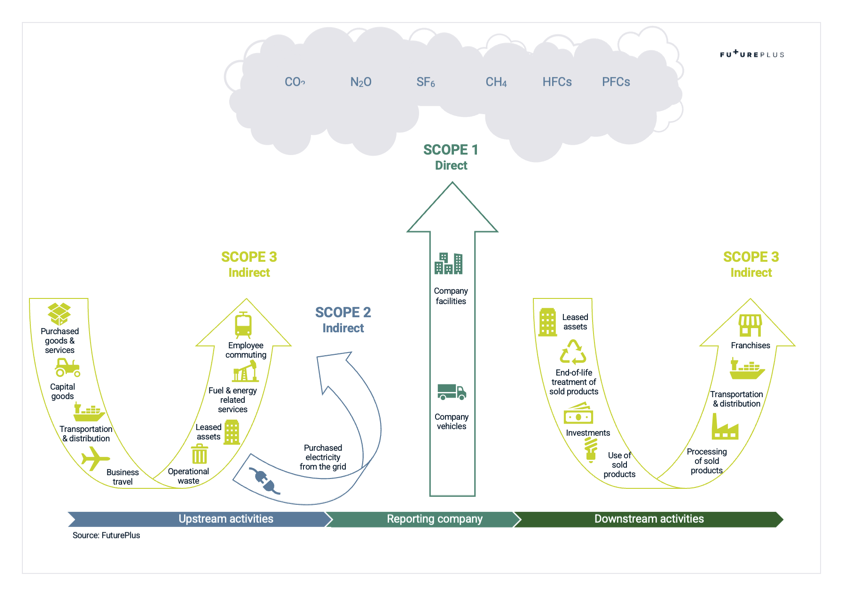Every single second, of every single day, your business activities will most likely be creating or using something that has created a gas which contributes to global warming and climate change, known as Green House Gasses (GHGs). The most common of these gasses is Carbon Dioxide (CO2), however there are many others such as Methane and Nitrous Oxide which also act as insulators warming the planet. To make the maths easier we calculate their effect as if they were Carbon Dioxide and call them Carbon Dioxide Equivalents (CO2e),
To address the global crisis of climate change, world leaders and scientists have set ambitious, necessary goals for worldwide emissions reductions. In 2021, the UK government set a globally leading carbon reduction target of 78% by 2035 compared to the 1990 level. To reach these targets, every business and every person needs to understand what this means for them.

Looking to understand your environmental impact as a business can often feel overwhelming. There are so many questions that may come to mind:
- What are your data points that paint a picture of your carbon footprint?
- Do any legislative or regulative reporting requirements apply?
- How will you capture the data clearly and efficiently?
On top of those, you will need to consider drilling down into the data to learn what it all means, and how to create reduction targets that satisfy the need to be ambitious, yet achievable. Like any big problem it is sensible to break it down into smaller chunks to work with. There is a convention on how to do this but looking at how the emissions are created wihtin the company’s operations. We call these chunks ‘scopes’. Understanding these scopes and how they apply to you might be the first challenge for your organisation.
What are scope 1, 2 and 3 emissions?

Scope 1 (Direct emissions): These are emissions from activities owned or controlled by businesses that release emissions into the atmosphere. They are direct emissions. Examples of scope 1 emissions include emissions from combustion in owned or controlled boilers, furnaces, and vehicles. It also includes emissions from chemical production in owned or controlled process equipment.
Scope 2 (Energy indirect): These are emissions released into the atmosphere associated with the consumption of purchased electricity, heat, steam, and cooling. These are indirect emissions that are a consequence of a business’s activities, but which occur at sources they do not own or control.
Scope 3 (Other indirect): These are emissions that are a consequence of your actions, which occur at sources businesses do not own or control and are not classed as scope 2 emissions. Examples of scope 3 emissions are business travel by means not owned or controlled by an organisation, waste disposal which is not owned or controlled, or purchased materials or fuels.
Where to start
The very first step to capturing emissions data is understanding the sources of where you are creating these emissions and gathering data from these sources on a monthly basis for a year. This data will be classed as your baseline data and is an essential step in enabling you to set targets. Scope 1 and Scope 2 data is a good place to start, and once you have established these, the next step is understanding your Scope 3 emissions, which is often more complicated.
If you are in a landlord-owned building, there’s an additional complication, especially if it is in shared premises. But it doesn’t mean you’ve failed at the first hurdle. It can feel daunting knowing what questions you need to ask to obtain the data you need, but more often than not landlords or managing agents will be happy to work together to provide the information you need. At the end of the day, they want to keep their tenants happy, and we should all be working towards the common goal of doing better for our planet! If this data isn’t available, there are a few other options out there.
One option includes using estimation methodologies such as data extrapolation if you have multiple sites, where data if available across some but not others. Another option is looking to approach your landlord to see whether they would agree for you to install your own meters for gas or electricity. Failing that, using Carbon Calculators (there are a multitude online), or carbon calculating experts who can provide advice and guidance on how to navigate this situation is another option. Whichever method is best for you and your business, ensure that you explain clearly the methodologies used and how the data has been captured, especially for auditing and data control purposes. And remember – if data is available, that should always be used.
Detailed below are some suggestions of what information to capture (please note this list is not exhaustive).
Scope 1
Gas
- Supplier
- Contract period
- Monthly kWh
- Data type (Estimated/ Measured/ Invoiced)
Fleet owned/ company owned vehicles
- Dates travelled
- Vehicle type (Car/ Van/ Lorry/ Motorbike etc.)
- Vehicle size (Small/ Medium/ Large)
- Fuel type (Petrol/ Diesel/ Hybrid/ Electric
- Distance travelled (km)
- Data type (Estimated/ Measured/ Invoiced)
Scope 2
Electricity
- Supplier
- Contract period
- Tariff type (Renewables?)
- Supplier
- Monthly kWh
- Data type (Estimated/ Measured/ Invoiced)
Getting into a rhythm of managing this data can be the biggest challenge, but once you have established this flow, capturing it regularly becomes easy.
Turning data into emissions calculations
Converting your gas, electricity, and any other environmental data you have captured (whether in scope 1, 2 or 3) into activity data is the next step. The UK Government publish conversion factors (created by DEFRA) on their website. The conversion factor spreadsheets provide the values which convert units of activity into units of CO2e to be reported, based on typical benchmarks. They also provide step-by-step guidance on how to use them.
The UK Government produce a new set of conversion factors each year, together with a methodology paper explaining how the conversion factors are derived, and a paper explaining the major changes in the latest year’s factors.
There are a number of calculators available online, like this one from The Carbon Trust for example, where you can enter your data and have your emissions calculated.
You can use your data to understand where your biggest impacts lie, and that will influence your decisions in where your focus to take action should be. There’s no point having data if you don’t use it, and it is the essential component in setting reduction targets, along with the KPI’s to help reach them.
Not only this, but you can use the data to inform key stakeholders of your current position and future ambitions, or publish your environmental data publicly, such as in non-financial reports.
Making bold decisions and being transparent on your impact can generate a wealth of benefits, and in the end, make your business a more responsible one.
Written by Jessica Hibberd and edited by Fleur Record Smith and Dave Caygill



